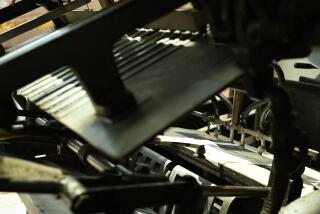Household Utilities
- Share via
Elbert Hubbard was an American original: a self-promoting idealist who gave up a successful career in soap marketing to become the shaggy-haired guru of the Roycroft Shops, the fine press and studios for furniture and copper and leather goods that he founded in 1897 in upstate New York.
The model for the shops was the Arts and Crafts movement founded by mid-19th century English reformer William Morris. His idea had been to replace shoddy, overdecorated manufactured furniture and accessories with handsome, functional, handmade objects styled after traditional rural English crafts dating to medieval days.
But nobody would confuse an elegantly detailed Morris & Co. piece with a simple Roycroft design, as is obvious from “Roycroft Desktop” at the Muckenthaler Cultural Center in Fullerton.
Circulated by the Burchfield-Penney Art Center at Buffalo (N.Y.) State College, the exhibition includes furniture and desk accessories as well as copies of Roycroft Press magazines (which may be handled) and facsimiles of ads that provide some insight into the quintessentially American bias of the Roycroft style.
Morris was himself a contradictory figure--a poet, artist and passionate Socialist who owned a country retreat and produced objects only the rich could afford.
But Hubbard was first and foremost a businessman. His unpretentious products targeted an optimistic yet sentimental prewar middle class imbued with aims of self-betterment.
Fra Elbertus, as Hubbard styled himself, reached some 200,000 homes a month with his magazines, the Philistine, Little Journeys and the Fra. Attractive typefaces and ornamental borders set off folksy essays supporting a grab bag of sometimes contradictory pet causes: women’s suffrage; workers’ rights; big business; the life-enhancing benefits of “reasonably pure” milk, air and water.
Hubbard advertised his magazines and goods with idiosyncratic gusto. He offered a book shrewdly titled “Little Journeys to the Homes of Great Lovers” as a premium for subscribing to the Fra (“a magazine devoted to the business of living!”) and coyly suggested that his thrifty desktop sets were a bit lavish, “but cold utility is not the mood in which you would write your friends.”
One Roycroft staple was the adjustable-back Morris chair in oak with a cushioned seat. It is a variant of a chair Morris & Co. designer Sidney Webb developed about 1866, based on an armchair used in the Sussex countryside.
The Roycroft model from about 1905 has a flip-up “reading attachment”--a nifty gadget designed to hold a book--but lacks the detailing and cushioned arms of the English original.
Other handsomely utilitarian pieces in the show, each carved with the high-minded orb-and-cross Roycroft insignia, include a sturdy round library table, a graceful bookcase with leaded glass doors, and a wastebasket smartly fashioned from mahogany slats bound with brass.
But while the furniture retains its honest appeal, the hammered copper goods--the bookends and calendar holders and such--look more like summer camp arts-and-crafts projects. Despite the selection of washes and patinas (silver, brass, “Italian polychrome” and a dreary “Aurora brown,” named after the studios’ hometown), hammered copper remains a flimsy-looking material.
The sweetly appealing designs from the ‘teens and ‘20s--a stylized owl’s head, a floral motif--are undercut by fussy detailing and crimped edges. And the copper medium simply wasn’t weighty enough for the bold patterning of the Art Deco era that followed.
These desktop pieces, generally sold in sets of six for $20 or less, are intriguing today mostly in a historical sense. How quaint the ink pots and rocker-like “roll” blotters now seem, not to mention the numerous styles of bookends, objects all but extinct in today’s households.
Yet a few of the accessories are still very appealing. The graceful glass-shaded lamps were the handiwork of studio designer Dard Hunter, whose stylized Glasgow roses (named for the Scottish Art Nouveau architect Charles Rennie Mackintosh) and decorative typefaces graced early editions of the Roycroft magazines. And who wouldn’t want to run off with the brightly patterned pieces of Buffalo Pottery china, designed for the Roycroft Inn, another Hubbard venture.
Exhibition curator John Vanco, director of the Erie Art Museum in Pennsylvania, claims in his catalog essay that the Roycroft output was of better quality and construction than Craftsman pieces (produced by the much better-known studio founded in 1898 by Gustav Stickley). But Vanco, who clearly is an unabashed Roycroft partisan, doesn’t go into detail.
Perhaps a future exhibition will allow viewers and collectors to compare the products of various Arts and Craft studios in this country and abroad, and investigate how they were influenced by personal taste, social values, available natural resources and market forces.
This show looks very much at home in the wood-paneled rooms of the center, built in 1924 as a private home. If the Muckenthaler chose to specialize in well-researched exhibitions of furniture and decorative arts, it might contribute something unique to the county as well as find a broader audience.
Incidentally, the slender computer-printed catalog ($10) is an eccentric treat. Vanco’s wryly off-the-cuff text and the vintage typefaces and borders are equally apropos. Hubbard, who eventually was seduced by machine printing, likely would have been much impressed.
*
“Roycroft Desktop,” through Aug. 17 at the Muckenthaler Cultural Center, 1201 W. Malvern Ave., Fullerton. Hours: 10 a.m.-4 p.m. Tuesday-Saturday, noon-5 p.m. Sunday. Admission: $2 adults, $1 students and seniors, free for children under 12. (714) 738-6595.
More to Read
The biggest entertainment stories
Get our big stories about Hollywood, film, television, music, arts, culture and more right in your inbox as soon as they publish.
You may occasionally receive promotional content from the Los Angeles Times.










